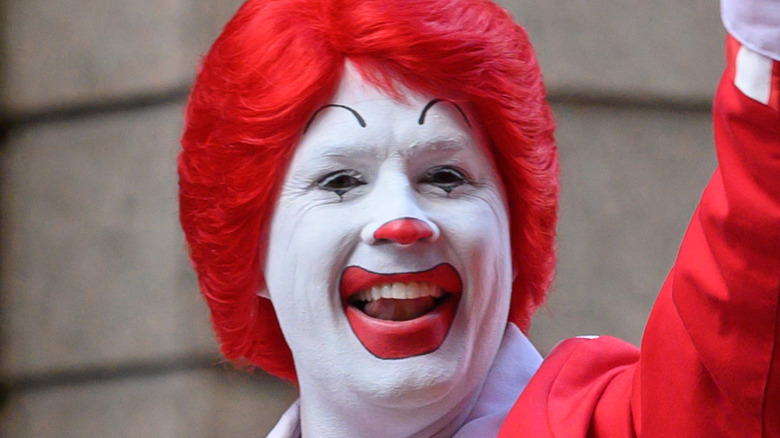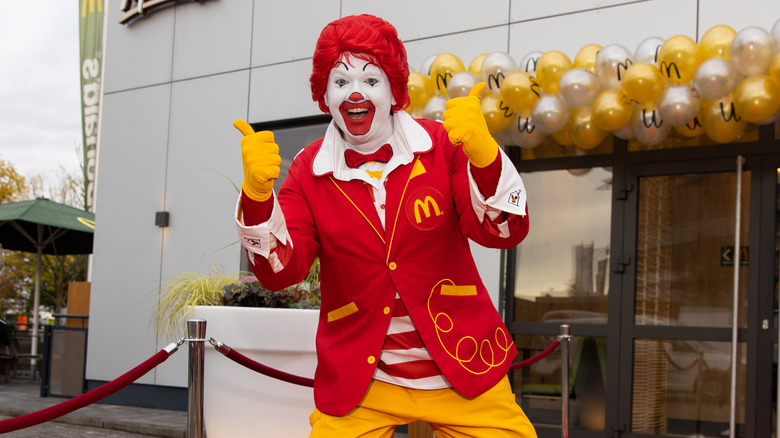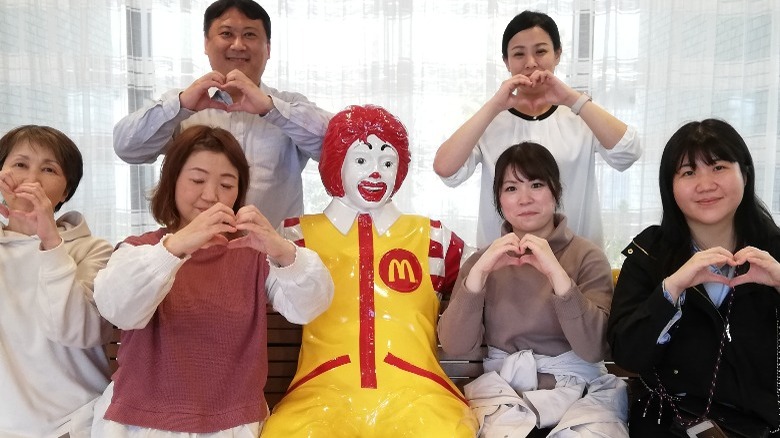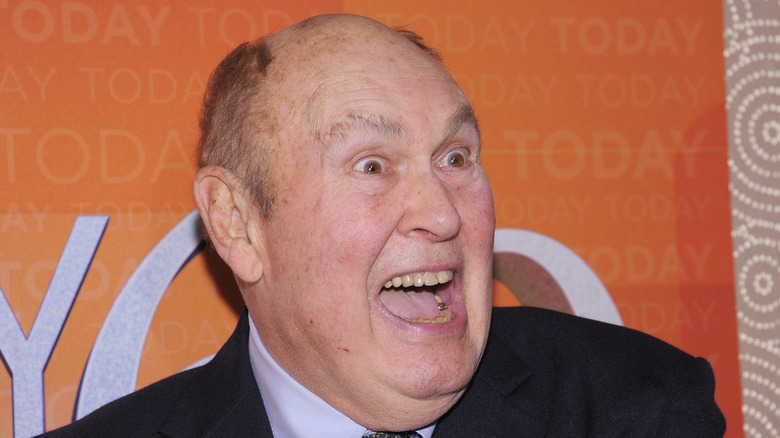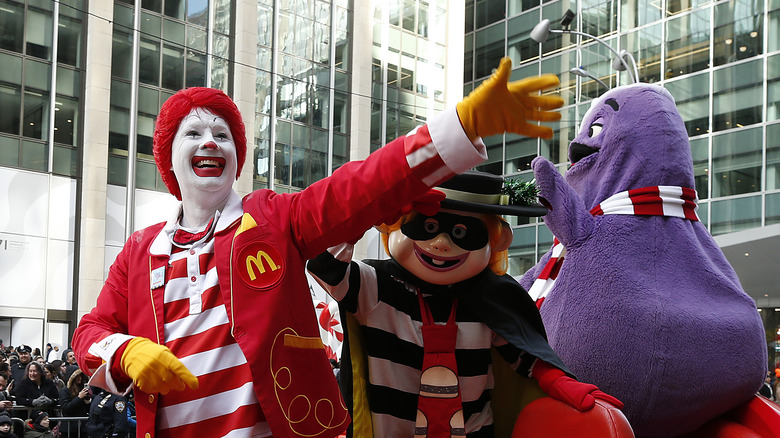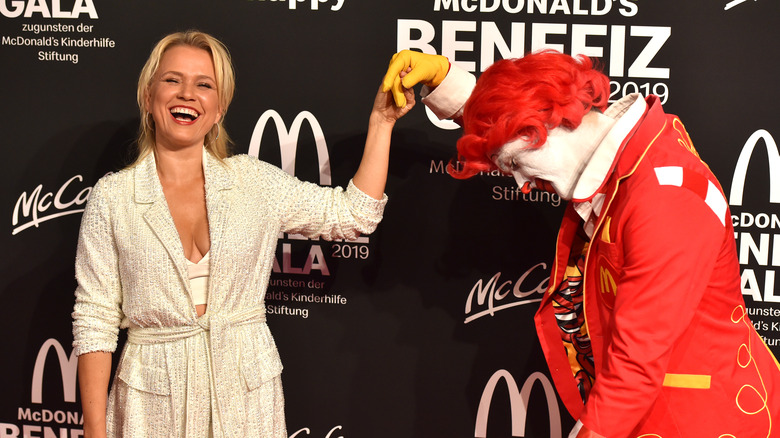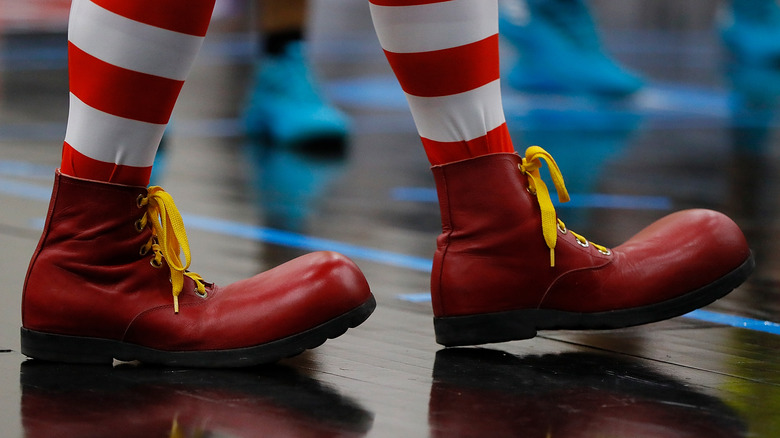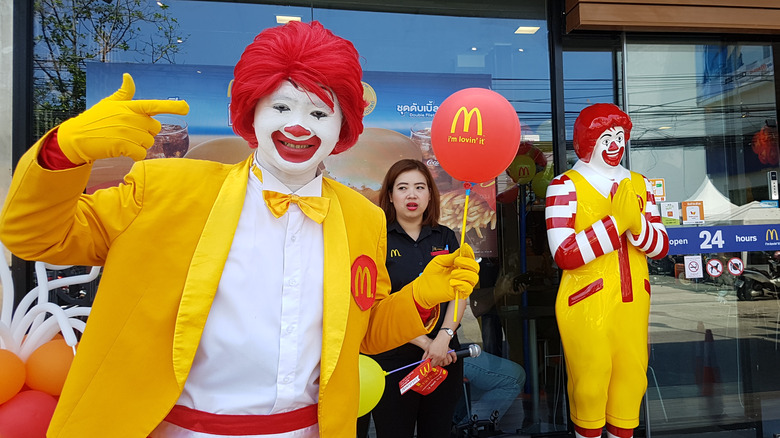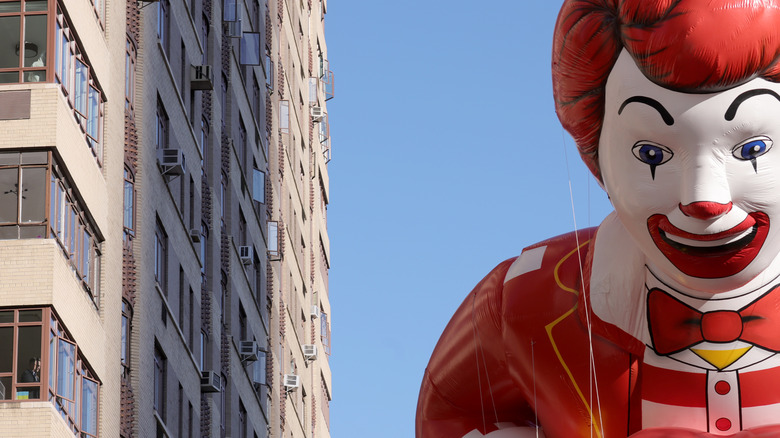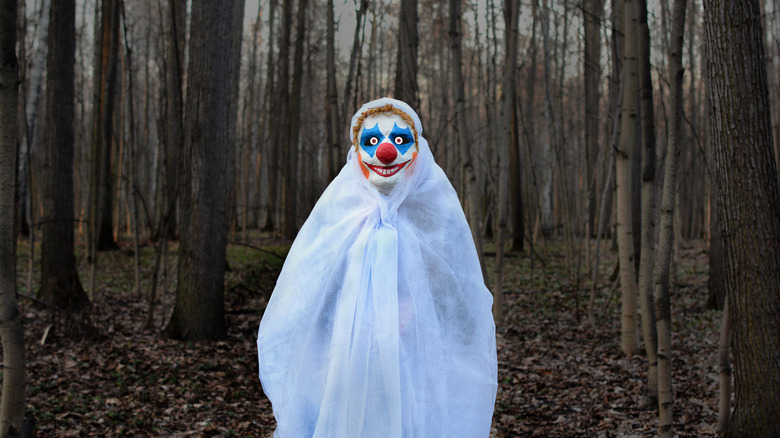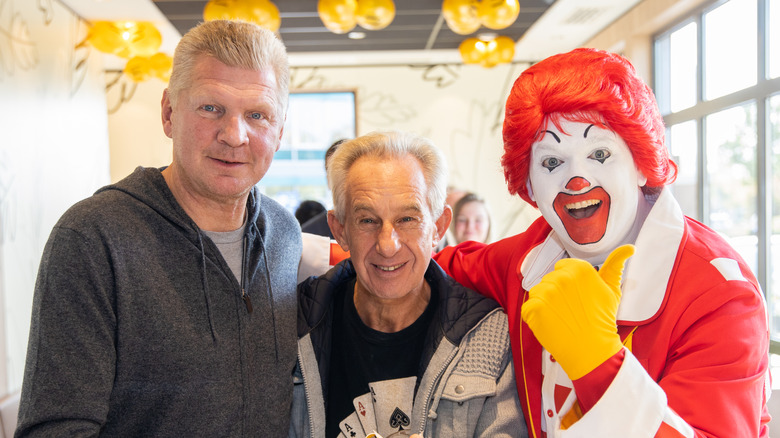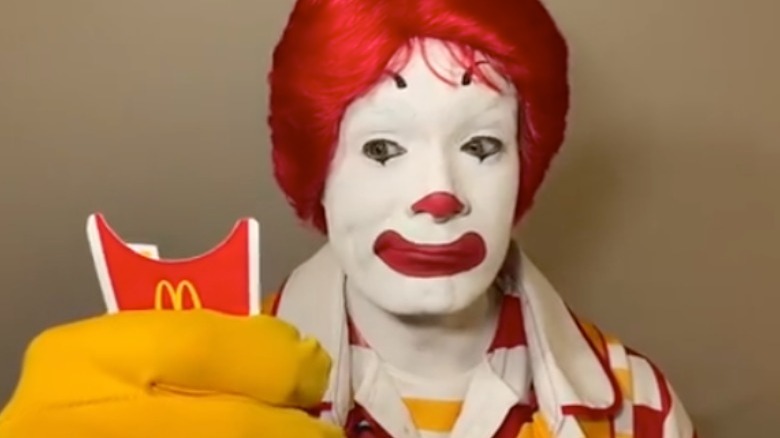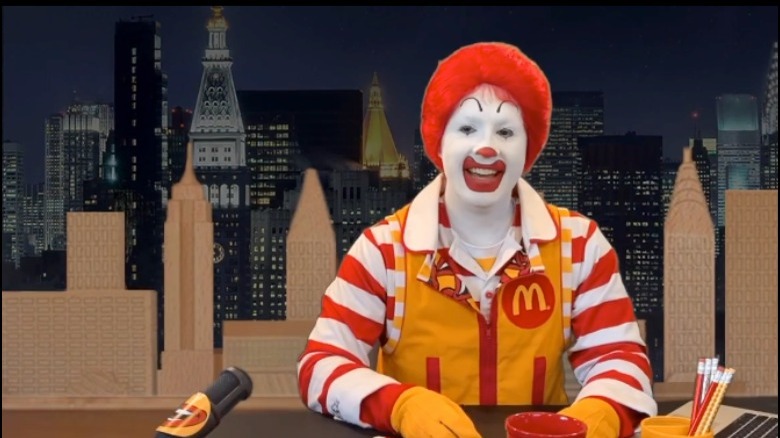Things About Ronald McDonald You Only Notice As An Adult
Most of us have fond memories of Ronald McDonald from our childhood. However, as adults, there are a few things about the clown from the McDonald's fast food chain we've come to notice. With fewer clowns in the public eye these days, we're more likely to appreciate his ability to put smiles on our faces. However, there are other things we've noticed, including how he's never played by a woman or how fit and spry he is. And most of us never questioned his choice of friends as a child, but now we have to wonder why he tended to hang out with criminals. We're looking at you, Hamburgler.
Something else you've probably noticed is that you haven't seen him around as much anymore. When was the last time you saw him in a McDonald's commercial? Probably a while. What about the last time you saw his image in a McDonald's restaurant? It's probably been quite some time unless your local McDonald's has a leftover statue from Ronald's heyday. We've uncovered the reason behind a lot of things you may have noticed about Ronald McDonald as an adult as well as where he may still be hiding out these days.
His outfit and makeup are a walking advertisement
Back in the 1960s, Barry Klein was doing the advertising for both McDonald's and the "Bozo the Clown" television show at the same time. So, he had the brilliant idea of combining the two and getting McDonald's to run ads during the children's show. The first McDonald's clown was a bit awkward looking, with a McDonald's cup for his nose and a cardboard serving tray hat filled with toys and Styrofoam McDonald's food items. He also sometimes had a tray attached to his waistband that could hold a fake drink and fries and could magically produce hamburgers from his costume. Something you may not have noticed as a kid is that Ronald's eyebrows are arch-shaped to resemble McDonald's golden arches. So, the look hit all the selling points it should, but it was a bit too much.
After the "Bozo the Clown" show ended in 1963, Klein kept one of the Bozos, Willard Scott (yes, the "Today" show weatherman), as the McDonald's mascot and hired a previous Bozo, Michael "Coco" Polakovs, as a wardrobe consultant. The resulting costume kept the big red smile, arched eyebrows, and gloves. It also continued to feature the restaurant's main colors, red and yellow, while adding the iconic arch emblems to the ensemble. Switching from white to yellow gloves now makes Ronald McDonald's fingers remind us of french fries. Luckily, they also replaced his shag-carpet wig with a lady's bright-red wig to modernize and complete the look.
In Japan, he answers to a different name
Anyone who has gone with friends from Japan to eat fast food at McDonald's has probably noticed they don't say McDonald's the same way we do in English. They give it lots of extra syllables. When native Japanese speakers say "Makudonarudo" instead of "McDonald's," it's not a mispronunciation. It's simply a change of Ronald's name to fit the Japanese language pronunciation patterns. Similarly, Ronald McDonald has a different name in Japan: Donarudo Makudonarudo. It's the equivalent of Donald McDonald instead of Ronald McDonald.
There are several reasons why the Japanese Ronald is a Donald (or Donarudo) instead. The English "r" sound at the beginning of the word "Ronald" is notoriously difficult for some native Japanese speakers to say. In Japanese, the letter "r" sounds like something between an "l" and an "r" to our English ears. However, Ronald is Japanized to Ronorudo, but it doesn't sound right because the "ro" part is too close to the "ru" part, turning the name into a tongue twister. When McDonald's came to Japan, people were already familiar with Donald Duck, whom they call "Donarudo." So, it seemed like an easy leap to change Ronald McDonald's name to the Japanese equivalent of Donald McDonald –- Donarudo Makudonarudo.
Current incarnations of Ronald McDonald are required to be fit
McDonald's eventually dumped the first Ronald McDonald because of his size. The chain worried that if it kept a larger mascot on staff, it would need to continue hiring large Ronalds to keep the image consistent. Is there really a shortage of large men who want to be a clown? With Willard Scott being 6 feet and 3 inches tall and 290 pounds, maybe so. Regardless, Scott was heartbroken to learn his size was an issue when it came to continuing his mascot gig. While the U.S. has laws against employment discrimination based on such things as race, gender, or religion, only Michigan has laws these days prohibiting employment discrimination based on weight.
Despite being the mascot for a fast food chain later notorious for supersizing its food, McDonald's didn't want a supersized Ronald McDonald. Instead, it wanted a mascot who could be spry and energetic in its television ads. In fact, in 2004, McDonald's started calling him a "balanced, active lifestyles ambassador," dressing him in workout clothes and turning him into a soccer and basketball player (via CNBC).
He was once surrounded by shady characters
Ronald McDonald started out as the sole mascot for McDonald's. However, from 1971 to 2009, other characters joined him in commercials for the fast food chain. If you missed the comic book series from the early 1970s, you probably felt like you were missing a backstory and wondered why the storyline included food thieves Captain Crook and Hamburgler. McDonald's got rid of Captain Crook in 1987 after 15 years of the pirate stealing Filet-o-Fish sandwiches and occasional cheeseburgers. However, the despicable Hamburgler continued burgling burgers until about 2002 (he briefly returned for a 2015 ad campaign).
Most of us never had any idea what Ronald McDonald's purple bell-shaped sidekick Grimace even was, but it turns out he was supposed to be a gigantic taste bud whose sole purpose was to remind us how tasty McDonald's food is. However, even goofy, lovable Grimace had a dark side and started life as Evil Grimace who was known for stealing milkshakes and scaring children. Obviously, having a character that would give children nightmares didn't work out too well, so his persona had to change. Sadly, even nice Grimace abandoned Ronald by 2003.
In addition to all the shady characters who wandered in and out of McDonaldland, there were a few nice ones like Birdie, the Professor, Officer Big Mac, and the Mac Tonight moon. So, while McDonaldland was riddled with food crime, there were also plenty of people paying for their burgers, shakes, and fish sandwiches.
He's notably standoffish (no hugs for you)
Roy Bergold and Aye Jaye wrote a book in 1972 called "Ronald and How" to help standardize everything about the McDonald's brand mascot. They offered instructions on dress and makeup as well as sanctioned behavior. Anyone who has a less-than-savory image of clowns can rest assured that Ronald is going to remain in character and be the type of happy-go-lucky clown that puts a smile on most kids' faces.
One thing that Ronald will never do is hug you or your child, which is a good choice when children are learning the difference between good and bad touches. A brief pat on the back is the most you'll ever experience from the red-wigged clown. Sure, there's a 2014 study from the Association for Psychological Science that says hugs are good for stress relief and keeping us healthy. While hugs certainly have their advantages, we don't necessarily want them from strangers — even one as well-known as Ronald McDonald.
He refuses to answer the tough questions
The same handbook that keeps Ronald McDonald from hugging you or your kids also stipulates what he can and can't say. For example, if your children want to know where hamburgers come from, he's absolutely not allowed to tell them that the meat comes from a cow, which could be devastating to a child who loves animals. Sure, it's the truth, but there are lines he won't cross, especially if it could result in a child becoming a vegetarian and never wanting to eat a McDonald's burger again.
In fact, Ronald McDonald has his own type of fast food catechism that provides exact answers to questions that customers might have. For example, if you ask him how much he makes playing the role of the chain's mascot, he's directed to say that what he's doing isn't work; he's just having a good time. If he doesn't have a scripted answer for a tough question, he's supposed to tell you to "ask someone wearing normal shoes" (via Yahoo).
There can be only one
Have you ever noticed that, even though there might be hundreds of Ronalds out there, you never see multiple Ronalds together unless they're cosplayers? You might see 10 Elvises at a time, but you'll never see 10 real Ronalds together. That's because there are strict rules explaining that only one Ronald can appear at a time.
Being a local Ronald McDonald is actually not a bad gig, and it's far more complicated than you'd imagine. Once recruited through CW & Co. Productions, they had to be willing to relocate to an area that needs a mascot. They often had a chauffeur drive them from gig to gig and even had their own bodyguard to help avoid rock-throwing kids and protesters. Local Ronalds once earned from $40,000 to $100,000 a year, depending on how many appearances they scheduled.
It might be possible to find multiple Ronalds together to photograph — if only you knew the location of the top-secret McDonald's convention the chain puts on every other year. But, alas, nobody is leaking that information. And there have been times when he has appeared in multiple countries on the same day for special events. But if ever asked how he could be in so many places in one day, the company insists there's only one Ronald and that perhaps his magical ability to appear across the globe in a single day is similar to that of Santa Claus.
Surveys found he's most often referred to as creepy
Back in 1963, when Ronald McDonald was still in need of a makeover, a disturbing commercial appeared on television screens across the U.S. In it, Ronald convinces a little boy to go with him to McDonald's even though the boy knows he shouldn't talk to strangers or accept gifts from them. However, since Ronald could produce hamburgers from his magic belt, he must be safe.
A commercial where Ronald McDonald kidnaps a kid certainly wouldn't go over very well today. Plus, more people have started to view clowns as creepy rather than as characters to cheer us up.When McDonald's surveyed test audiences in 2011 about commercials it was thinking of airing on television, more and more reviewers used the word "creepy" to describe their feelings toward Ronald McDonald. It certainly made McDonald's rethink its clown-based marketing.
But is Ronald really creepy? The chain has been extremely strict about who could represent the chain. While the company vets each Ronald with a comprehensive background check, at least one creep has slipped through the cracks and into the role. In 1998, Joe Maggard (a substitute Ronald for one of the chain's commercials) turned out to be a bad hiring choice. Maggard was arrested on a weapons charge and went to court again the next year for making prank calls as Ronald McDonald. While Maggard certainly falls under the creepy category, he's definitely not the norm.
The clown sightings of 2016 were a real problem for him
Unfortunately for Ronald's reputation, sinister clowns started appearing in random locations worldwide in 2016. The first reports came from South Carolina in August, and disturbing clowns were soon popping up everywhere. People were seeing them walk down deserted stretches of road, into the countryside, or through city lots both day and night. While many were just dressing up for fun, others tried to lure kids into the woods, ran at people, or brandished real weapons to incite terror. There were several clown arrests in 2016. However, the only Ronald McDonald believed to have been arrested that year was a statue version that was blocking foot traffic in Guangzhou, China.
If you started to notice Ronald McDonald disappearing from sight in 2016, it's because of all the rampaging clowns. Terri Hickey talked to CNN that year on behalf of McDonald's to say that, in light of the "current climate around clown sightings," the company would be more "thoughtful as to Ronald McDonald's participation in various community events." However, Hickey assured fans that this thoughtfulness "does not mean that there will be no appearances by Ronald McDonald."
You don't really see him much anymore
We often don't notice what's missing when it's not there anymore. However, if you try to remember the last time you saw Ronald McDonald, most of us have to reach back quite a few years in our memories.
The McDonald's website in the U.K. confirms his intentional disappearance from ads but says he still makes special appearances in the community and restaurants. Plus, he continues to visit his namesake Ronald McDonald Houses to cheer up sick children.
You could blame the shift in viewpoint on clowns as being creepy or the sinister clown debacle of 2016. However, people have been protesting against the Ronald McDonald mascot for years since advertising campaigns featuring him all target children. In 2011, 550 doctors came together to insist that McDonald's remove him from its marketing efforts, pointing out how many kids were becoming unhealthy from eating so much junk food. When Ace Matrix studied McDonald's ads in 2013, it found that Ronald had become less of an asset for the company. So, it was definitely time for the McDonald's chain to reconsider having a clown represent its restaurant brand in such a big way.
The official face beneath the clown makeup has always been a man's
While McDonald's once had over 250 Ronalds it could call upon for marketing and appearances at any one time, there was always an official Ronald in the U.S., and it was always a man. Those are the ones who once raked in over $300,000 a year as the company's official mascot.
The earliest official Ronald McDonald was Willard Scott, who landed the role in 1963. He only played Ronald for two years before being replaced by a string of clown actors who tended to keep the job for only a couple of years. Bob Brandon was the first actor to hold onto the part for five years, starting in 1970. When Brandon announced he was gay in 1977, McDonald's took Brandon to court to protect the image of its mascot, whom they didn't want to be seen as being gay.
Most Ronald McDonalds since 1975 have been able to stay in the role for a significant amount of time. King Moody still holds the record for reigning as Ronald for 16 years, from 1969 to 1985. David Hussey also did an impressive 14-year stint as Ronald from 2000-2014. However, the last Ronald we saw in commercials was Brad Lennon, who began the role in 2014.
His Insta, albeit somewhat neglected, is everything
While we haven't seen Ronald McDonald and his McDonaldland friends for a while on television, he was quite active on Instagram for a time. However, after getting packed for a road trip in 2021, he hasn't returned. Should we send out a search party?
Ronald McDonald's Instagram was extremely active during the early days of the COVID-19 pandemic. If you were among his 59,900 followers, you would have been treated to entertaining videos showcasing some of his many talents. He displayed his juggling skills and performed magic tricks, like throwing one Christmas ornament at the fireplace to magically decorate his entire living room. In fact, we learn that he is absolutely obsessed with the winter holiday season. His Insta has everything from jokes to trivia and a late-night talkshow to keep fans entertained. Some of his old McDonaldland friends, like Birdie, Grimace, and the Hamburgler, even make occasional appearances on the Instagram account. This Ronald McDonald reminds us why clowns were once so popular as entertaining diversions.
He's been the face of the Ronald McDonald House for around five decades
1974 marks the year when McDonald's first joined forces with a children's hospital in Philadelphia, Pennsylvania, to provide a place for families to stay while their sick children received medical care. Ronald McDonald Houses are currently in 51 countries worldwide to help relieve some of the emotional and financial stress for worried parents of sick children. However, did you know that, despite featuring the Ronald McDonald name, these charities all operate as separate entities? They each have boards of directors comprised of people from the community rather than ones connected to the McDonald's corporation. While McDonald's still provides some funding, a large portion of the budget comes from fundraising efforts.
Even though Ronald McDonald hasn't shown up in McDonald's commercials since 2016, he still remains the face of Ronald McDonald House. Representatives for Ronald McDonald House call him the "CEO of Happiness" (via YouTube). In this role, he still visits sick children in hospitals to try to bring brightness and cheer to them while they undergo treatment. Plus, many of the fundraising efforts the charity uses to raise money each year — like Red Shoe Day — continue to use Ronald McDonald mascots. So, if you see a Ronald on a street corner near you asking for money for Ronald McDonald House, you know he's there for a good cause.
